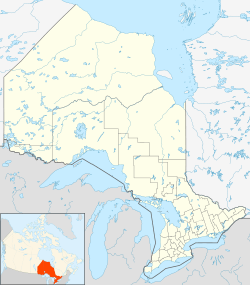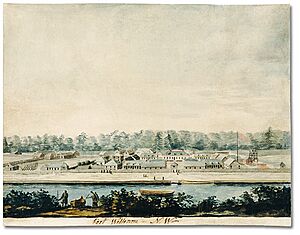Fort William, Ontario facts for kids
Quick facts for kids
Fort William, Ontario
|
|
|---|---|

Skyline of part of Fort William
|
|
Fort William was a city in Ontario, Canada. It was located on the Kaministiquia River, right where it flows into Lake Superior. In January 1970, Fort William joined with Port Arthur and the areas of Neebing and McIntyre. Together, they formed the new city of Thunder Bay.
Since then, Thunder Bay has been the biggest city in Northwestern Ontario. Fort William's Latin motto was A posse ad esse. This means From a possibility to an actuality. This motto was on its coat of arms, which was designed in 1900. The coat of arms showed an Indigenous person and a French voyageur. It also featured a grain elevator, a steamship, and a train. A beaver sat on top of the whole design.
Contents
Exploring Fort William's Past
Early Fur Trade Days
Fort William and Grand Portage were important starting points. They were the beginning of a canoe route from the Great Lakes to Western Canada. This route was used for trading furs.
French Trading Post
The Kaministiquia area was first mentioned in 1681. In 1683 or 1684, a French trader named Daniel Greysolon, Sieur du Lhut set up a trading post here. This post was near the mouth of the Kaministiquia River.
The French government closed this post in 1696. This was because there were too many furs on the market. In 1717, a new post called Fort Kaministiquia was built. It was also at the river's mouth. This post was left empty around 1758 or 1760. This happened during the British takeover of New France.
British Fur Trade Centre
After the British took over, the fur trade quickly started again. Most traders used Grand Portage. By 1784, merchants from Montreal formed the North West Company. These traders were often called "Nor'Westers."
The North West Company kept using Grand Portage. But after the American Revolution, this area became part of the United States. A treaty in 1794 confirmed American control. This meant the North West Company needed a new place to trade. They needed a spot where their goods could be moved (a transshipment point). This new place had to be between their inland posts and Montreal. It also needed to be free from American taxes.
In 1803, the Nor'Westers left Grand Portage. They built a new fur trading post on the Kaministiquia River. They bought the land from the Ojibwe people in 1798. In 1807, the post was named Fort William. It was named after William McGillivray, a main leader of the North West Company.
After 1821, the North West Company joined with the Hudson's Bay Company (HBC). Fort William became less important for trade. Most trade moved to York Factory on Hudson Bay. Fort William then became a smaller HBC trading post. The original site of the fort was later covered by railway tracks in the 1880s.
Today, a copy of Fort William has been built further up the Kaministiquia River. It is called the Fort William Historical Park. It shows what the fort looked like long ago.
Growth and Development
In 1859–1860, two areas called Neebing and Paipoonge were mapped out. The Fort William Town Plot was also surveyed. These areas were opened for people to settle. Many people bought land, hoping that a railway would be built there.
The Canadian government decided to build a railway to the Pacific Ocean. It would start near the north shore of Lake Superior. The Fort William Town Plot was chosen as the eastern end of the railway. This choice helped the area grow quickly. Construction of the railway began in June 1875. It took seven years to build the railway line from Fort William to Winnipeg, Manitoba.
In March 1873, the Municipality of Shuniah was created. This was an early form of local government. It covered a very large area. For eight years, people in Neebing and Port Arthur argued about where the railway terminus should be. In March 1881, the people of Neebing successfully asked to separate from Shuniah. They formed the Municipality of Neebing.
By 1883–1884, the Canadian Pacific Railway (CPR) preferred the lower lands along the Kaministiquia River. This area was better than the exposed shores of Port Arthur. Port Arthur would have needed an expensive breakwater to protect its port. So, the CPR built all its main operations in Fort William. They built rail yards, coal handling areas, grain elevators, and a machine shop.
In April 1892, parts of Neebing were made into the town of Fort William. Fort William became a city in April 1907. The city of Fort William officially stopped existing at the end of December 1969.
Well-Known People from Fort William
Many notable people have connections to Fort William:
- Jack Adams, a professional hockey player, coach, and general manager.
- Mary J. L. Black, the first librarian of the Fort William Public Library.
- Gus Bodnar, a professional hockey player.
- Larry Cahan, a professional hockey player.
- Joe Comuzzi, a lawyer and government minister.
- Tom Cook, also known as Tommy Cook, a professional hockey player.
- Alex Delvecchio, a professional hockey player.
- Jeff Heath, a professional major league baseball player in the 1930s and 1940s.
- Bora Laskin, who became the Chief Justice of Canada.
- Danny Lewicki, a professional hockey player.
- Paul Shaffer, a famous musician and TV personality.
- H. J. Sterling, a president of the Canadian Amateur Hockey Association.
See also
 In Spanish: Fort William (Ontario) para niños
In Spanish: Fort William (Ontario) para niños



